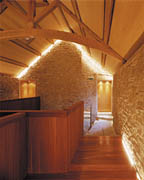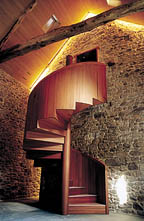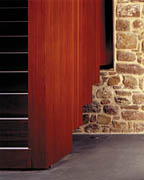

The name of the estate is derived from the Scandinavian word "Thorp," meaning "village," a term that is used in this area of Normandy for rural buildings. Originally, Tourp manor was the property of a noble family, whose coat of arms still hangs on the stained glass windows of the chapel. In addition to the chapel, the property includes an old manor house, a dovecote and other various buildings.
It was the district of La Hague which initiated the restoration, with the intention for the new operation to be a place where visitors will be able to inquire about tourist activities in the region, local life and traditions, history and the natural habitat of the La Hague peninsula. Additionally, a restaurant will be open for tourists, and some accommodations will be available for hikers.
Inside, several walls are clad from the ceiling to floor with local fieldstone. The exposed stone combined with wood beams creates a rustic feel for the interior. In some areas, the stonework showed weaknesses and required extensive pinning, according to French architect Patrick Mauger, explaining that it was necessary for the walls to be strengthened.
"To restore the interior walls that were weakened, cement was injected into the walls," said the architect. "In fact, the walls were composed on both sides with good stone, with the interior space between them originally filled with clay that had disintegrated over time. To make the two surfaces connected again, the exterior joints of the walls were tuck pointed, with cement then pumped in through hoses into the interior space."
To satisfy safety standards, two staircases had to be built in each building. Mauger designed two spiral staircases and two other straight staircases with handrails. One of the spiral staircases was carved from exotic wood and built into the stone walls. Because of the narrowness of the location, the staircase had to be turned in order to fit correctly in the building.
Complementing the fieldstone walls, Green Amazone granite from China was employed for the floor in the rooms on ground level. According to Mauger, each piece was 70 x 70 cm with a thickness of 3 cm. While the appearance of the granite is identical to that extracted locally in Cotentin, the material was imported from China because it was not possible to extract the local granite in a sufficient quantity, explained the architect.

Repairing the roof
The restoration process also involved strengthening the roof structures to support heavier loads while retaining their original appearance. Originally, only the living quarters on the manor had a roof of thick schist slate tiles. The other structures were thatched, covered with clay tiles and then finally covered with a thin slate. Because schist roofing slates are twice as heavy - the weight of the new roof is on average 29 pounds per square foot - it was necessary to double the number of rafters in the roof."Before restoration, the distance between the roof's trusses was quite large - around 5.5 meters - with straining struts along the walls which transferred the weight to the floor," said Mauger. "The roof supported a covering of thin and lightweight Angers slate. The new roof in schist slate is much heavier. The number of trusses was doubled - one every 2.75 meters - and designed to do away with the straining struts, thus opening up the wall space to allow exhibits to be hung." The architect explained that the new roofing structure was designed with the assistance of the specialized engineering and design department RFR, which participated in the design of the Louvre Pyramid.
According to Mauger, all of the roof coverings were renovated with salvaged stones. "It was not possible to find new ones," he said. "They tried to reopen a quarry and train masons over a period of 18 months, but it just was not possible. Even for the Mont Saint Michel Abbey, which is located in the same region of France, one cannot find stone." Today, only one local schist quarry is open, which was not capable of producing the 10,800 square feet of slate that was required for the roofing of Tourp Manor.
The architect explained that it took two months per building to restore the roof coverings. "The [schist slate] was laid in descending order, with the larger and heavier stones laid first at the bottom of the roof. Each piece measures around 50 cm long and 25 to 30 cm wide, with thicknesses between 1 to 3 cm. The pieces are irregular in all of their dimensions."
The smallest stones are situated in the roof's ridge beam, according
to Mauger. "These stones have dimensions of 15 cm long x 10 cm wide," he said. "Stones were laid from the bottom of the roof to the ridge beam, with the first stone jutting out and going beyond the edge of the roof to direct water far from the outer wall. The traditional stone laying was respected. These stones are fixed to the roof lath by dowels made of chestnut or oak. An artisan, Jacques Hochet, did this work."
The restoration of Tourp Manor required careful collaboration between all those involved. While construction of the restaurant still has to be completed, the buildings and grounds were open to the public in March 2002.

END BOX
Tourp ManorCotentin Peninsula
Normandy, France
Architect: Patrick Mauger
Stone Supplier: Rocamat Cominex (Chinese granite)
Stone Installer: Martin Gregoire
Engineer: RFR
